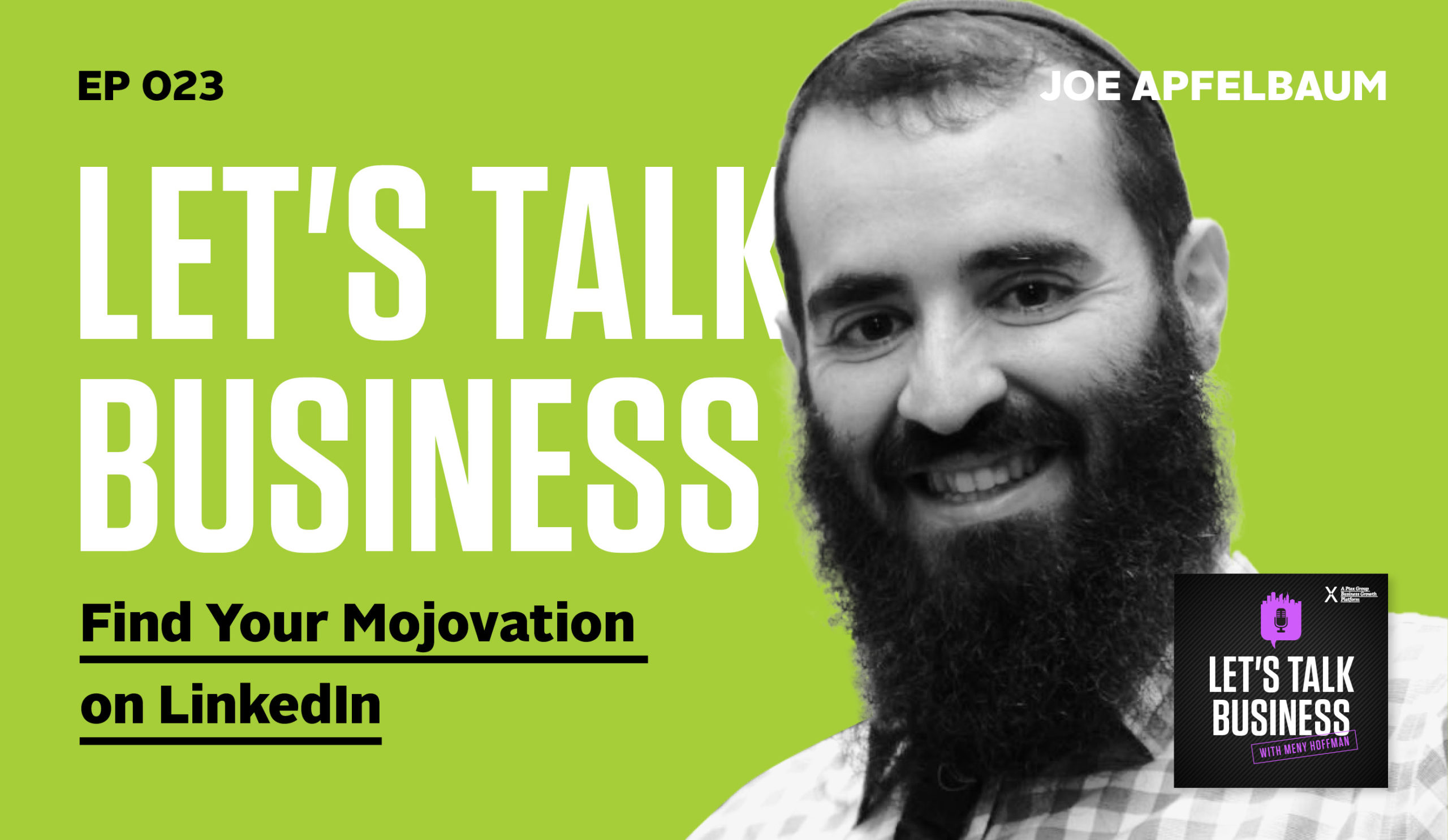The Queen of Cold Calling, Wendy Weiss, is back! This time, she's sharing even more useful tips for how to make a successful cold call—and why cold calling presents a unique opportunity during the current pandemic.
Are you struggling to find leads during these trying times, when the networking events you once relied on have been shut down and knocking on the doors of brick-and-mortar stores is nearly impossible?
If lead generation is a big concern for you, I urge you to listen to my latest interview with Wendy Weiss, the Queen of Cold Calling. You might remember Wendy as an earlier guest on the LTB podcast and I’ve invited her back to the show due to popular demand. Wendy teaches the art of prospecting via phone and why it has become even more essential during these times of the global pandemic.
In our interview, Wendy discusses ways to leverage the phone for your sales process. She outlines the correct mindset for making a successful cold-call, how to introduce yourself as soon as your prospects pick up, and what you should be asking them to do next by the time the call is over. We also went through different objections prospects often raise and how to overcome them. This follow-up episode is full of golden nuggets if you’re planning to use the phone to boost sales.
Listen and enjoy!
Listen to the podcast here:
Download the audio file here.
Cold Calling: How To Make That Introductory Call Part 2—with Wendy Weiss
Wendy, thank you so much for joining me on the show.
Thank you for inviting me to return. I’m happy to be here.
For our readers, this is the first time we have somebody returning as a guest and you would probably ask why. The answer is this podcast is all about no-nonsense advice. The first time we spoke about cold calling and this opened a ton of conversations with people that are reading the blog on a regular basis. Even people outside of the regular readers knew about it and subscribe to the show because of that episode. I had a bunch of people reach out to me and with questions that I figured out, we’ll bring you on again. Things change and the times are different a little bit and let’s get Wendy back, The Queen of Cold Calling, to answer some of those questions.
Speaking about the phone, we are in the pandemic of COVID-19 which is uncertain times for a lot of people trying to creep out slowly but surely. We need to mention many people that lost jobs and many people that lost their lives. It’s a very troubling time for general people, business people, salespeople and people that use the phone in particular. What would you start based on what you’re seeing in the marketplace for salespeople using telephone as the primary way of reaching people?
You’re right that it is a difficult time. For salespeople, one of the things that have made it even more difficult is you might be as a salesperson or a business owner where pre-COVID, you were able to simply walk into a place of business, asked to speak to the owner and have the conversation that you wanted to have. Now, that’s not something that you can easily do. I’ve had a lot of people that are doing our programs that this is what they experienced. They were used to walking in and they can’t do that anymore. What’s the alternative? You can reach out on the telephone and connect with the people that you want to connect with and have the conversation that you want to have.
One of the questions I get asked all the time is, “Can you reach people on the phone?” What’s interesting is what has happened. The first few weeks of the pandemic when everything was shutting down and businesses were very chaotic. It was hard to reach people but most businesses have figured it out now. Even though people might be working remotely, the phone system is set up, the calls are being forwarded, and worst-case scenario, people are calling in getting their voicemails. You actually can reach people. What is interesting and what we’re seeing is you can reach more people because people are feeling isolated. Even after six months, they’re not used to working at home. They’re used to being around people and a lot of them are chatty. They’re very willing to engage. One more thing, there was an article in the New York Times a couple of months ago about this phenomenon that people are much more open to talking on the phone than they were in the past. Verizon reported that the daily call volume that they are fielding for both personal and business calls is higher than what they typically see on Mother’s Day. Mother’s Day is the highest call volume day of the year.
[bctt tweet=”You have to learn to deal with rejection.” username=””]
One of the things that resonated very well with the audience last time is a line that I’ve been using since, which was that in personal life and you used the analogy of ice cream, “Ice cream, you love or hate, and you eat certain things based on what you love or you hate. You don’t have to love doing cold calling, but you’ve still got to do it because it’s one of the systems your business needs.” That was an eyeopener for many because if this is what I need to do, I’ve got to do it regardless if I love it or don’t. That also changed a little bit with the situation where people love walking into an office building, going knocking on door to door and getting those appointments but they never paid attention to cold calling. Now, if that’s not an option, what is left? The phone. Let me start doing it even if I don’t love it.
If you think of this as a business process, because it is what it is by which businesses get more business. One of the dumb things that people say about this topic is, “It’s rejection.” You have to learn to deal with the rejection. Who wants to do that? Here’s a way to look at it. If you’re making your calls and you are not getting the response that you want to get, that is data that tells you that what you’re doing isn’t working. You need to do it in a different way.
Let’s say you get a prospect on the phone, you introduce yourself and they say, “I’m not interested,” and hang up, which does happen sometimes. What that tells you is you don’t have a strong introduction because if you say something that gets someone’s attention, then they’re going to be willing to engage with you. A negative response doesn’t mean that this business process will not work. What it means is that you’re not doing it well yet, but the good news is you can learn to do it. I learned to do it. I was lucky early in my career as somebody taught me this skill that enabled me to build a business.
Let me dive deeper into this because a question that came in was, “What is the best opening line to say when you get that person?” This person was a salesperson that has been doing visits and cold visits on a regular basis into office buildings and lobbies of buildings. Another guy told me that his business model was hanging around like the WeWork just meeting people and opening up conversations that led into filling up his pipeline with business. The question is, in that case, when they meet somebody face to face, they right away could see the mood of the person. They could see how far it should go, how much I should introduce myself, how much should I speak about my product or listen to the person about their baseball game and whatever it is. On the phone, you don’t have that. What would you say for that person that needs to transition into phone? How should that introductory line look like?
I cannot give you a generic introduction because generic doesn’t work. This like real life. The rule is what you say has to be relevant to the person that you plan on saying it to. The question that our readers want to ask themselves is, “What is the challenge that your clients or your customers have that you can help them with? How do they talk about it?” Not how do you talk about it but how did they express this challenge? When you cold call a prospect, there are two things they want to know. Who are you and what do you want? They don’t want to know all about your product yet. You need to have an introduction.
The template that we use in our core program is called 3X Appointments. We call it 3X because people routinely triple their numbers. We work with each person in the program on exactly what they’re going to say and how they’re going to introduce themselves. One of the templates we give them is we have a track record of helping our clients, plugin how your clients are better off after they work with you. It’s like dating. When you’re reaching out to a prospect to set up an appointment, you’re not trying to get them to buy from you on the spot but you’re trying to get them to agree to have an in-depth conversation. That’s my definition of the word ‘appointment,’ that the prospect agrees to have an in-depth conversation.
That conversation might happen on the phone. It might happen on a Zoom call, maybe one day soon or eventually, you’ll be able to get in your car and go see them. They agree to have a real conversation with you so this is just like dating. If there is somebody you want to date, you have to ask them to go on a date with you before you go on the date. Appointment setting is like asking for the date. You need to say enough to get someone’s attention and ask them for an appointment. Once they say yes, then you get to go on the date, or then you have that appointment which is the in-depth conversation.
That first initial conversation is about introducing who you are, what do you want and pique the person’s interest that they should at least give you the opportunity to meet in person or via Zoom or have that follow-up conversation where you go into more details about your products and services.

The language that we recommend to ask for the appointment starts, “I’d like to introduce myself,” and whatever the company name is firstly. You’re not saying, “Give me your credit card right now or dump your vendor, hire us.” You’re saying, “I’d like to introduce myself. I’d like to have a conversation with you.” That’s a very low-key way of asking and it works well. The same way you’re going to ask for that date, you’re not going to say, “Do you want to get married on Tuesday?” First, you want to ask for a date, “Would you like to get a cup of coffee, dinner or a movie?”
Let’s speak about certain objections that people get when they introduce regardless of how well the introduction is positioned. The typical rejection they would get from someone would be, “We already are fine. This problem is already taken care of with our current vendor.” How does the person go to step two even on that first call if they are faced with resistance? That person doesn’t even want to give them that time to calm down, explain why they’re different, and why they are better suited to solve that problem ongoing. How would you overcome that?
Let’s take a step back. Your prospect says, “They’re already working with someone.” That is good news. That means, one, they understand the value. You don’t have to convince them there’s value there. Two, it means they have a line item in their budget to pay for it. If you weren’t sure, you now know you are speaking with a qualified prospect. If you think back to what we were talking about, when you asked for an appointment, what you’re asking for is some time to have an in-depth conversation. You are not saying, “Dump your vendor, hire me or give me your credit card in the next three minutes.” You’re saying, “I’d like to introduce myself.” If you think of it in that manner, the fact that they’re working with someone is irrelevant to your goal of wanting to introduce yourself. You can simply say, “That’s great. I simply like to introduce myself, that way, if your situation changes, you’ll know me.” You sidestep the issue entirely.
I like that because sometimes the potential client, prospect or whatever you want to call them, they even respect that. Meaning to say, nobody wants to feel that, “All you want to do is to take away the business from this other guy that’s dealing with us for many years.” When they see that you are phrasing the opportunity. I want you to know there are other sources. If that person can’t deliver or whatever reason you feel that you want to have another option you want to compare, “Here we are, so I want to introduce myself.” Sometimes it comes across very respectful.
One of the biggest mistakes that I see people make is they start doing this compare and contrast thing, “Does your vendor do this, that and the other thing? Has your vendor told you about this or that?” What they’re doing is they’re making the prospect wrong. Most people don’t take kindly to that.
As I mentioned before, when you meet somebody in person, obviously you could feel the vibe of the person and the surroundings to see is if this the right time to go ahead and ask for that introductory meeting or whatever it is. Sometimes, you pick up that phone and the person on the other side, you could sometimes feel the tension and sometimes not, but most of the time you could feel some tension. At which point is it not the right time and rather than not go to the full introductory? Do you coach people that should always go for the introductory or sometimes feel that the timing isn’t right?
The issue that I see is that a lot of people seem to think they can read minds. The truth is that when you get another human being on the phone, especially if it’s a cold call, you do not know this person. All you know is what they say. When we’re coaching people in our 3X Appointments Program, the question that I always ask is, “What did they say?” There are the facts and they’re the stories that people tend to tell themselves about the facts. The facts are the person said hello and they were in the middle of something. The story is, “He really didn’t want to talk to me. I didn’t want to bother him so I disengaged.” If somebody says they’re busy, “I understand you’re busy. When is the better time to talk? Can we carve out sometime later this afternoon? Is tomorrow morning better?”
How much should a person push for? You mentioned there’s the yes or yes analogy. Instead of saying, “When are you available?” it is actually to propose, “Do you have some time in the afternoon or tomorrow?” It’s less of a chance of a person who will say, “None of the above.” Is there a part that you would coach people that should be the language they’re using?
[bctt tweet=”If you say something that gets someone’s attention, then they’re going to be willing to engage with you.” username=””]
It’s always better to offer choices because it changes the conversation from if they’ll schedule the appointment to when they’re scheduling the appointment. If you say, “Can we carve out some time tomorrow or is one day next week better?” They’re choosing. It’s broad, but you’re looking at your calendar when you do that. Even if they say, “I can’t do it next week.” “No problem. Do you want to look at the week after or is the week after that better?” I keep giving them choices until they pick something because I want them to pick.
I want to speak about fear. This is probably your favorite word. When you speak to people or coach people on cold calling. It’s the fear of rejection. As much as we spoke about it the last time. For our readers that didn’t pay attention in the beginning. If you love this content, and if you feel that you appreciate this topic, please go back and find the first episode that we did together, that was full of golden nuggets. That would be a great start. If you’re looking to enhance your cold calling business process as Wendy dimensions in this interview. Back to speaking about fear, most people have fear of rejection. They are frustrated and feel that, “I made some calls in the past and got rejected.” Speak to them directly. What would you tell them?
I would say, first of all, if you are afraid and if you are uncomfortable, it’s not your fault and you’re not alone. Many people feel afraid. Many people are very uncomfortable with the idea of picking up the phone and talking to people that they don’t know. There is a huge disservice that has been done over many years. The way far too many people talk about this topic because they say things like prospecting sucks, get over it. Rejection comes with the territory or it’s about learning to go through the noes and the hang ups until somebody says yes to you. Who wants to do that? I don’t want to do that. If you think of it instead that it’s a business process. I have been training people for about several years and what I have seen over and over again is that when people learn a very simple, easy to follow system, which is what we teach and they know exactly what you’re going to do, what you’re going to say and how you’re going to say it.
If the prospect says they’re working with someone, you know what to say. If the prospect says, they’re busy, you know what to say. There’s not a situation that’s going to come up that you don’t know how to handle yourself. You’re always prepared, so much of that fear goes away because a lot of it is also the fear of the unknown, “What do I say if they say this or that?” Here’s the thing. This process is very predictable. We know what prospects say. If they don’t immediately say yes, we know what they’re going to say. It’s entirely possible to be prepared for it. The idea is not that you need to love this. My goal for each of the people that take our 3X Appointments program. I want you to be neutral. I want to take the emotion out of this because it doesn’t need to be an emotional experience. It is a business process.
What I’ve seen over the years is that when people learn the process and they start having success, the fear goes away. Whenever we do the 3X Appointments Program, in the very last session, I ask everybody in the program, “What’s changed for you over the last three months?” We do the program for over three months. They all say some version of, “I call my prospect, get them on the phone, I say what I have to say, and they book an appointment with me.” They say it like that. They’re very matter of fact. When it’s something you do and we take all the emotion out of it, it’s easy to be good at it and it’s easy to be successful.
That’s one thing that I spoke for a group of salespeople. I told them that, “Anytime you get a no, rejection or whatever it is in that form, think for a moment that that person lost way more than you lost.” Which means if you believe in your product and service and they told you no, it’s their loss, even more than it’s your loss. You are here to deliver value. You had a great product and a great solution. That will give you the courage and the motivation to continue doing it.
Let me piggyback on that. We touched on this that sometimes what you might hear as rejection is not actually rejection. I mentioned this that when we’re coaching people, the question I always ask is, “What did they say to you?” One client says, “I called this prospect and they rejected me.” I say, “What did they say?” A lot of people think that, if a prospect says they’re working, they have a vendor, or they’re working with someone.
A lot of people would say, “I got rejected.” You didn’t get rejected. They’re working with someone, but that’s okay because you’re not calling them up and saying, “Dump your vendor and hire me.” You’re saying, “I’d like to introduce myself.” Maybe they’ll say they’re busy. That’s not rejection. Everybody that you call is going to be busy. They’re all busy. Now, you’re negotiating when. When are they not going to be busy so they can set up the appointment so you can have an in-depth conversation? A lot of the things that prospects say, people take as being rejected but you’re not being rejected. The key is, what is it that they said to you? Not your interpretation of what they said, but what did they say and not your emotions.

Let me ask you a question which is based on where you’re seeing the market is going and how it affects sales calls by phone. What are you seeing in the market that you could share?
A lot of people have been affected. A lot of industries have been affected. What’s important is to look at your market. I’ll give you an example. From the first podcast that I did with you, Meny. Somebody heard that podcast and did attend our 3X Appointments Program. He did credit card processing and he was used to walking into restaurants. Clearly, that was not something that he was going to be able to do. Even if he could call them on the phone, they weren’t going to be great bets for him or several months ago when he was doing the program. What we did with him is we helped him look at the market and figure out what other markets he could go after.
That’s what a lot of businesses need to do. That’s what we had to do. In my company, one of the markets that we’ve been in for years is commercial real estate, which has been impacted. We had to look around and make that pivot. That’s the word everybody is using these days to say, “What’s a different market that we can go into?” Because of COVID, the messaging needs to change. You might have been a great effective prospector pre-COVID, and you might find what you’re saying, how you’re approaching prospects, isn’t resonating because the situation is different. Reworking that messaging and reworking that introduction is going to be critical as well.
Is there anything that people could download to get familiar a little bit with, if they want to start figuring out what they do and how they do the cold calling that you could share?
We have several free gifts. The Business Owner’s Guide to Scheduling More Qualified Appointments When their Prospects are All Completely Freaking Out. That is the title of the guide and it’s twelve steps for finding sales opportunities. You can download the guide and follow it like a map. Different ways to find sales opportunities. We also have, The Cold Calling Survival Guide. This is a step by step system to start scheduling more qualified appointments.
Let’s close with the four rapid-fire questions. Number one is a book that changed your life.
There was a book on hypnotic selling, which is kind of a woo-woo title, but it was all about scripting and about the importance of the language that you use. Donald Moine is the author.
Number two, a piece of advice you got that you’ll never forget?
My first career was a ballet dancer. I trained as a ballet dancer. I danced in a ballet company for many years. When I was a young dancer, I was going through a difficult time and ballet dancers, just so our audience knows, you take a class every single day. You have a teacher. Sometimes you take 3 or 4 classes a day. That’s how you become a ballet dancer, you keep dancing. I was going through some stuff. I was unhappy. I stopped taking the class. I hadn’t been there in a couple of months.
[bctt tweet=”Sometimes, what you might hear as rejection is not actually rejection.” username=””]
I showed up one day and my teacher wanted to know where I had been. I told her all these terrible things that were happening in my life. She looked at me and she said, “That’s no reason not to take the class.” I thought about it and I decided that she was right, because dancing was something that I love. All I was doing was making myself feel worse because of all this stuff that was going on plus I wasn’t doing the thing that I love. What I learned from that as a dancer, you take a class every day, no matter what. When I started my business, I took that lesson and I realized that I needed to prospect. Look for business opportunities and look for sales every day, no matter what.
Number three, anything you wish you could go back and do differently?
When I started my business, I was very taken with my own abilities. You don’t know what you don’t know. I assumed that because I was smart and I read a lot that I’d be able to figure everything out and that’s not true. If I were starting my business, I would probably hire more consultants and more coaches as soon as I get to afford it early on. That would have helped me avoid some of the mistakes that I made in my business when I thought I could figure it all out myself.
Last and final question, what’s still on your bucket list to achieve?
I want to stop working so hard. I’m driven and I’m not sure if that’s a good thing, but I don’t know how to stop.
As long as we help people be successful, that’s always what counts. Working less is always good. Wendy, thank you so much for joining us. I know your time is valuable and that is why in the name of our readers, we will forever be grateful for sharing some of your time with us.
It’s my pleasure. Thank you for having me here.
It was a pleasure.
Links Mentioned:
- Wendy Weiss – Previous episode
- Wendy Weiss
- 3X Appointments
- The Cold Calling Survival Guide
- Book – Unlimited Selling Power: How to Master Hypnotic Selling Skills
- www.ColdCallingResults.com
- https://www.Facebook.com/coldcallingresults/
- https://Twitter.com/wendyweiss
- https://www.LinkedIn.com/in/wendyweiss
About Wendy Weiss
 Wendy Weiss is known as The Queen of Cold Calling™. She is an author, speaker, sales trainer, and sales coach, and she is recognized as one of the leading authorities on lead generation, cold calling, and new business development. Her clients include Avon Products, ADP, Sprint, and thousands of entrepreneurs throughout the world.
Wendy Weiss is known as The Queen of Cold Calling™. She is an author, speaker, sales trainer, and sales coach, and she is recognized as one of the leading authorities on lead generation, cold calling, and new business development. Her clients include Avon Products, ADP, Sprint, and thousands of entrepreneurs throughout the world.
Wendy has been featured in the New York Times, BusinessWeek, Entrepreneur Magazine, Selling Power, Inc, Forbes, and various other business and sales publications. She is the author of, Cold Calling for Women: Opening Doors & Closing Sales and The Sales Winner’s Handbook, Essential Scripts and Strategies to Skyrocket Sales Performance.









